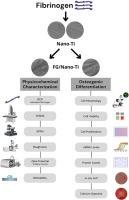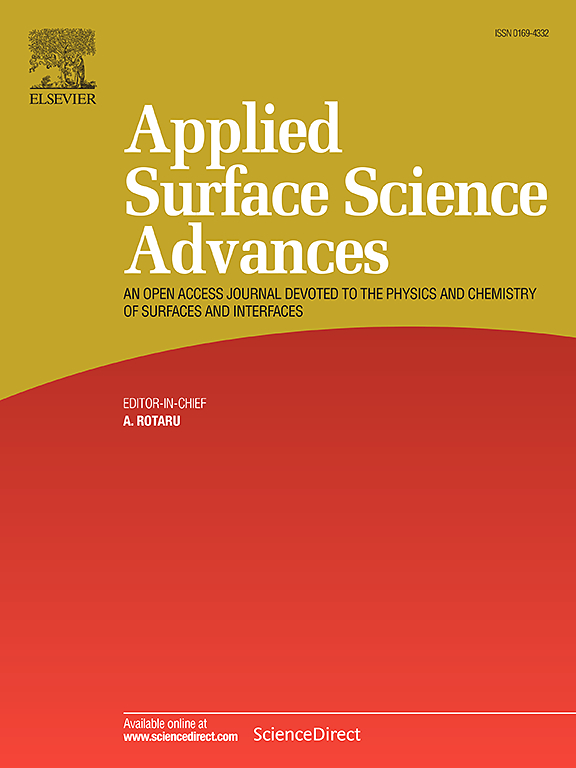Titanium surface functionalization via fibrinogen-coated nano-topography: Physicochemical surface characterization and pre-osteoblastic cell response
IF 8.7
Q1 CHEMISTRY, PHYSICAL
引用次数: 0
Abstract
The aim of this study was to evaluate fibrinogen (FG) coating on a nanostructured titanium surface (Ti) regarding its physicochemical properties and the response of pre-osteoblastic cells in vitro. Commercially pure Ti discs were ground and chemically treated with a 1:1 mixture of 30% hydrogen peroxide and concentrated sulfuric acid (Nano-Ti). FG coating was performed by simple adsorption at its plasma concentration (FG/Nano-Ti). Pre-osteoblastic MC3T3-E1 cells were plated on Nano-Ti and FG/Nano-Ti and cultured for up to 18 days. FG/Nano-Ti resulted in the availability of 0.7 mg/cm2 of protein on FG/Nano-Ti (BCA). Nano-Ti and FG/Nano-Ti exhibited microscale grooves and a typical nano-topography, with a network of nanopores, which was partially masked for FG/Nano-Ti by the presence of granulated material of homogeneous distribution. The adsorbed protein layer was continuous and probably a few nanometers thick, not affecting the micro-grooves of Nano-Ti. The roughness parameters exhibited higher values for FG/Nano-Ti. Zeta potential titration curves showed an isoelectric point at pH 3.5 for Nano-Ti evidencing hydroxyl functional groups with a weak acidic reactivity and 5.5 for FG/Nano-Ti, which is the same as FG, in agreement with a continuous adsorbed layer. The presence of FG reduced the wettability of the nano-topography in contact with a drop of water or fetal bovine serum, but enhanced it when a blood drop was used. The biological results showed a higher expression of classical osteoblast markers – especially RUNX2 – on FG/Nano-Ti, which corresponded to higher values of alkaline phosphatase activity and mineralization of the cultures. When FG/Nano-Ti was exposed to exogenous thrombin, a homogeneous fibrin fibril was assembled. In conclusion, the strategy of coating FG/Nano-Ti with FG potentiates the capacity of Nano-Ti to promote osteogenic differentiation.

通过纤维蛋白原包覆纳米形貌的钛表面功能化:物理化学表面表征和成骨前细胞反应
本研究的目的是评价纤维蛋白原(FG)涂层在纳米结构钛表面(Ti)的理化性质和体外成骨前细胞的反应。用30%过氧化氢和浓硫酸(纳米钛)的1:1混合物研磨商业纯钛片并进行化学处理。在其血浆浓度(FG/纳米ti)下,通过简单吸附进行FG涂层。将成骨前MC3T3-E1细胞分别镀于纳米ti和FG/纳米ti上,培养18天。FG/Nano-Ti在FG/Nano-Ti (BCA)上可获得0.7 mg/cm2的蛋白质。纳米ti和FG/纳米ti表现出微尺度的沟槽和典型的纳米形貌,具有纳米孔网络,FG/纳米ti部分被均匀分布的粒状材料所掩盖。吸附的蛋白质层是连续的,厚度可能在几纳米左右,不影响纳米钛的微凹槽。FG/Nano-Ti的粗糙度值更高。Zeta电位滴定曲线显示,纳米ti的等电点在pH值为3.5,表明羟基官能团具有弱酸性反应活性;FG/纳米ti的等电点与FG相同,为5.5,与连续吸附层一致。FG的存在降低了纳米形貌与一滴水或胎牛血清接触时的润湿性,但与一滴血接触时则增强了润湿性。生物学结果显示,经典成骨细胞标志物,尤其是RUNX2在FG/Nano-Ti上的表达较高,这与培养物的碱性磷酸酶活性和矿化值较高相对应。当FG/Nano-Ti暴露于外源性凝血酶时,组装成均匀的纤维蛋白原纤维。综上所述,FG/纳米ti涂层策略增强了纳米ti促进成骨分化的能力。
本文章由计算机程序翻译,如有差异,请以英文原文为准。
求助全文
约1分钟内获得全文
求助全文

 求助内容:
求助内容: 应助结果提醒方式:
应助结果提醒方式:


